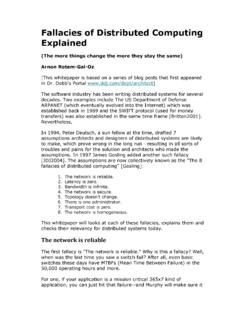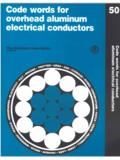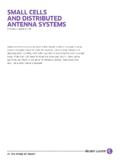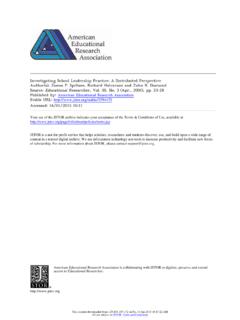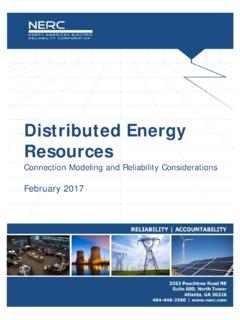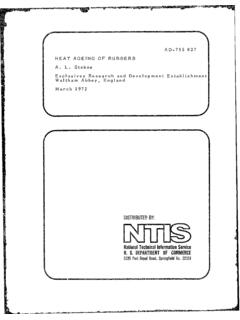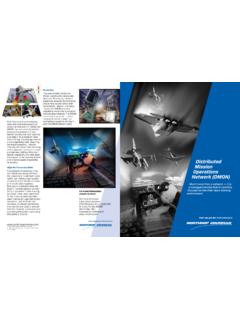Transcription of Distributed Representations of Words and Phrases …
1 [ ] 16 Oct 2013 Distributed Representations of Words and Phrasesand their CompositionalityTomas MikolovGoogle SutskeverGoogle ChenGoogle CorradoGoogle DeanGoogle recently introduced continuous Skip-gram model is an efficient method forlearning high-quality Distributed vector Representations that capture a large num-ber of precise syntactic and semantic word relationships. In this paper we presentseveral extensions that improve both the quality of the vectors and the trainingspeed. By subsampling of the frequent Words we obtain significant speedup andalso learn more regular word Representations . We also describe a simple alterna-tive to the hierarchical softmax called negative inherent limitation of word Representations is their indifference to word orderand their inability to represent idiomatic Phrases .
2 For example, the meanings of Canada and Air cannot be easily combined to obtain Air Canada . Motivatedby this example, we present a simple method for finding Phrases in text, and showthat learning good vector Representations for millions of Phrases is IntroductionDistributed Representations of Words in a vector space helplearning algorithms to achieve betterperformance in natural language processing tasks by grouping similar Words . One of the earliest useof word Representations dates back to 1986 due to Rumelhart,Hinton, and Williams [13]. This ideahas since been applied to statistical language modeling with considerable success [1]. The followup work includes applications to automatic speech recognition and machine translation [14, 7], anda wide range of NLP tasks [2, 20, 15, 3, 18, 19, 9].Recently, Mikolov et al.
3 [8] introduced the Skip-gram model, an efficient method for learning high-quality vector Representations of Words from large amountsof unstructured text data. Unlike mostof the previously used neural network architectures for learning word vectors, training of the Skip-gram model (see Figure 1) does not involve dense matrix multiplications. This makes the trainingextremely efficient: an optimized single-machine implementation can train on more than 100 billionwords in one word Representations computed using neural networks are very interesting because the learnedvectors explicitly encode many linguistic regularities and patterns. Somewhat surprisingly, many ofthese patterns can be represented as linear translations. For example, the result of a vector calcula-tion vec( Madrid ) - vec( Spain ) + vec( France ) is closer to vec( Paris ) than to any other wordvector [9, 8].
4 1 Figure 1:The Skip-gram model architecture. The training objective is to learn word vector representationsthat are good at predicting the nearby this paper we present several extensions of the original Skip-gram model. We show that sub-sampling of frequent Words during training results in a significant speedup (around 2x - 10x), andimproves accuracy of the Representations of less frequent Words . In addition, we present a simpli-fied variant of Noise Contrastive Estimation (NCE) [4] for training the Skip-gram model that resultsin faster training and better vector Representations for frequent Words , compared to more complexhierarchical softmax that was used in the prior work [8].Word Representations are limited by their inability to represent idiomatic Phrases that are not com-positions of the individual Words . For example, Boston Globe is a newspaper, and so it is not anatural combination of the meanings of Boston and Globe.
5 Therefore, using vectors to repre-sent the whole Phrases makes the Skip-gram model considerably more expressive. Other techniquesthat aim to represent meaning of sentences by composing the word vectors, such as the recursiveautoencoders [15], would also benefit from using phrase vectors instead of the word extension from word based to phrase based models is relatively simple. First we identify a largenumber of Phrases using a data-driven approach, and then we treat the Phrases as individual tokensduring the training. To evaluate the quality of the phrase vectors, we developed a test set of analogi-cal reasoning tasks that contains both Words and Phrases . A typical analogy pair from our test set is Montreal : Montreal Canadiens :: Toronto : Toronto Maple Leafs . It is considered to have beenanswered correctly if the nearest representation to vec( Montreal Canadiens ) - vec( Montreal ) +vec( Toronto ) is vec( Toronto Maple Leafs ).
6 Finally, we describe another interesting property of the Skip-gram model. We found that simplevector addition can often produce meaningful results. For example, vec( Russia ) + vec( river ) isclose to vec( Volga River ), and vec( Germany ) + vec( capital ) is close to vec( Berlin ). Thiscompositionality suggests that a non-obvious degree of language understanding can be obtained byusing basic mathematical operations on the word vector The Skip-gram ModelThe training objective of the Skip-gram model is to find word Representations that are useful forpredicting the surrounding Words in a sentence or a document. More formally, given a sequence oftraining wordsw1, w2, w3, .. , wT, the objective of the Skip-gram model is to maximize the averagelog probability1TT t=1 c j c,j6=0logp(wt+j|wt)(1)wherecis the size of the training context (which can be a function ofthe center wordwt).
7 Largercresults in more training examples and thus can lead to a higher accuracy, at the expense of the2training time. The basic Skip-gram formulation definesp(wt+j|wt)using the softmax function:p(wO|wI) =exp(v wO vwI) Ww=1exp(v w vwI)(2)wherevwandv ware the input and output vector Representations ofw, andWis the num-ber of Words in the vocabulary. This formulation is impractical because the cost of computing logp(wO|wI)is proportional toW, which is often large (105 107terms). Hierarchical SoftmaxA computationally efficient approximation of the full softmax is the hierarchical softmax. In thecontext of neural network language models, it was first introduced by Morin and Bengio [12]. Themain advantage is that instead of evaluatingWoutput nodes in the neural network to obtain theprobability distribution, it is needed to evaluate only aboutlog2(W) hierarchical softmax uses a binary tree representationof the output layer with theWwords asits leaves and, for each node, explicitly represents the relative probabilities of its child nodes.
8 Thesedefine a random walk that assigns probabilities to precisely, each wordwcan be reached by an appropriate path from the root of the tree. Letn(w, j)be thej-th node on the path from the root tow, and letL(w)be the length of this path, son(w,1) = rootandn(w, L(w)) =w. In addition, for any inner noden, letch(n)be an arbitraryfixed child ofnand let[[x]]be 1 ifxis true and -1 otherwise. Then the hierarchical softmax definesp(wO|wI)as follows:p(w|wI) =L(w) 1 j=1 ([[n(w, j+ 1) = ch(n(w, j))]] v n(w,j) vwI)(3)where (x) = 1/(1 + exp( x)). It can be verified that Ww=1p(w|wI) = 1. This implies that thecost of computinglogp(wO|wI)and logp(wO|wI)is proportional toL(wO), which on averageis no greater thanlogW. Also, unlike the standard softmax formulation of the Skip-gram whichassigns two representationsvwandv wto each wordw, the hierarchical softmax formulation hasone representationvwfor each wordwand one representationv nfor every inner nodenof thebinary structure of the tree used by the hierarchical softmax has a considerable effect on the perfor-mance.
9 Mnih and Hinton explored a number of methods for constructing the tree structure and theeffect on both the training time and the resulting model accuracy [10]. In our work we use a binaryHuffman tree, as it assigns short codes to the frequent wordswhich results in fast training. It hasbeen observed before that grouping Words together by their frequency works well as a very simplespeedup technique for the neural network based language models [5, 8]. Negative SamplingAn alternative to the hierarchical softmax is Noise Contrastive Estimation (NCE), which was in-troduced by Gutmann and Hyvarinen [4] and applied to language modeling by Mnih and Teh [11].NCE posits that a good model should be able to differentiate data from noise by means of logisticregression. This is similar to hinge loss used by Collobert and Weston [2] who trained the modelsby ranking the data above NCE can be shown to approximately maximize the log probability of the softmax, the Skip-gram model is only concerned with learning high-quality vector Representations , so we are free tosimplify NCE as long as the vector Representations retain their quality.
10 We define Negative sampling(NEG) by the objectivelog (v wO vwI) +k i=1 Ewi Pn(w)[log ( v wi vwI)](4) 0 1 0 1 2 Country and Capital Vectors Projected by PCAC hinaJapanFranceRussiaGermanyItalySpainGr eeceTurkeyBeijingParisTokyoPolandMoscowP ortugalBerlinRomeAthensMadridAnkaraWarsa wLisbonFigure 2:Two-dimensional PCA projection of the 1000-dimensional Skip-gram vectors of countries and theircapital cities. The figure illustrates ability of the model to automatically organize concepts and learn implicitlythe relationships between them, as during the training we did not provide any supervised information aboutwhat a capital city is used to replace everylogP(wO|wI)term in the Skip-gram objective. Thus the task is todistinguish the target wordwOfrom draws from the noise distributionPn(w)using logistic regres-sion, where there areknegative samples for each data sample.
![arXiv:0706.3639v1 [cs.AI] 25 Jun 2007](/cache/preview/4/1/3/9/3/1/4/b/thumb-4139314b93ef86b7b4c2d05ebcc88e46.jpg)

![arXiv:1301.3781v3 [cs.CL] 7 Sep 2013](/cache/preview/4/d/5/0/4/3/4/0/thumb-4d504340120163c0bdf3f4678d8d217f.jpg)
![@google.com arXiv:1609.03499v2 [cs.SD] 19 Sep 2016](/cache/preview/c/3/4/9/4/6/9/b/thumb-c349469b499107d21e221f2ac908f8b2.jpg)






